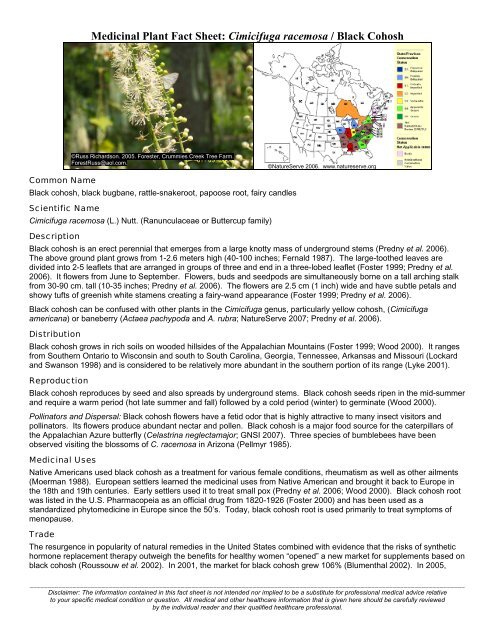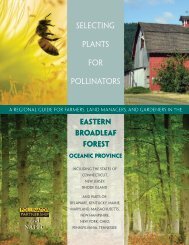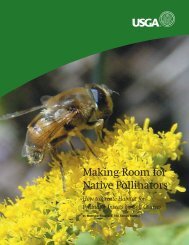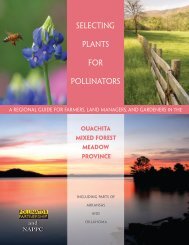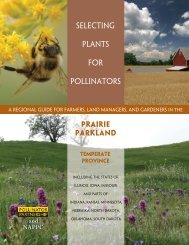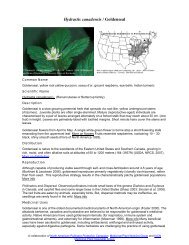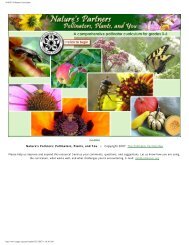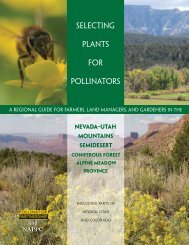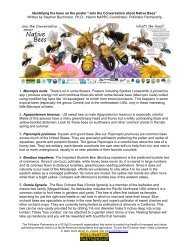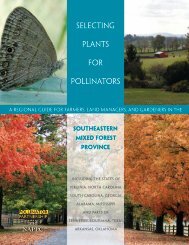Medicinal Plant Fact Sheet: Cimicifuga racemosa / Black Cohosh
Medicinal Plant Fact Sheet: Cimicifuga racemosa / Black Cohosh
Medicinal Plant Fact Sheet: Cimicifuga racemosa / Black Cohosh
You also want an ePaper? Increase the reach of your titles
YUMPU automatically turns print PDFs into web optimized ePapers that Google loves.
<strong>Medicinal</strong> <strong>Plant</strong> <strong>Fact</strong> <strong>Sheet</strong>: <strong>Cimicifuga</strong> <strong>racemosa</strong> / <strong>Black</strong> <strong>Cohosh</strong>©Russ Richardson. 2005. Forester, Crummies Creek Tree Farm.ForestRuss@aol.com.©NatureServe 2006. www.natureserve.orgCommon Name<strong>Black</strong> cohosh, black bugbane, rattle-snakeroot, papoose root, fairy candlesScientific Name<strong>Cimicifuga</strong> <strong>racemosa</strong> (L.) Nutt. (Ranunculaceae or Buttercup family)Description<strong>Black</strong> cohosh is an erect perennial that emerges from a large knotty mass of underground stems (Predny et al. 2006).The above ground plant grows from 1-2.6 meters high (40-100 inches; Fernald 1987). The large-toothed leaves aredivided into 2-5 leaflets that are arranged in groups of three and end in a three-lobed leaflet (Foster 1999; Predny et al.2006). It flowers from June to September. Flowers, buds and seedpods are simultaneously borne on a tall arching stalkfrom 30-90 cm. tall (10-35 inches; Predny et al. 2006). The flowers are 2.5 cm (1 inch) wide and have subtle petals andshowy tufts of greenish white stamens creating a fairy-wand appearance (Foster 1999; Predny et al. 2006).<strong>Black</strong> cohosh can be confused with other plants in the <strong>Cimicifuga</strong> genus, particularly yellow cohosh, (<strong>Cimicifuga</strong>americana) or baneberry (Actaea pachypoda and A. rubra; NatureServe 2007; Predny et al. 2006).Distribution<strong>Black</strong> cohosh grows in rich soils on wooded hillsides of the Appalachian Mountains (Foster 1999; Wood 2000). It rangesfrom Southern Ontario to Wisconsin and south to South Carolina, Georgia, Tennessee, Arkansas and Missouri (Lockardand Swanson 1998) and is considered to be relatively more abundant in the southern portion of its range (Lyke 2001).Reproduction<strong>Black</strong> cohosh reproduces by seed and also spreads by underground stems. <strong>Black</strong> cohosh seeds ripen in the mid-summerand require a warm period (hot late summer and fall) followed by a cold period (winter) to germinate (Wood 2000).Pollinators and Dispersal: <strong>Black</strong> cohosh flowers have a fetid odor that is highly attractive to many insect visitors andpollinators. Its flowers produce abundant nectar and pollen. <strong>Black</strong> cohosh is a major food source for the caterpillars ofthe Appalachian Azure butterfly (Celastrina neglectamajor; GNSI 2007). Three species of bumblebees have beenobserved visiting the blossoms of C. <strong>racemosa</strong> in Arizona (Pellmyr 1985).<strong>Medicinal</strong> UsesNative Americans used black cohosh as a treatment for various female conditions, rheumatism as well as other ailments(Moerman 1988). European settlers learned the medicinal uses from Native American and brought it back to Europe inthe 18th and 19th centuries. Early settlers used it to treat small pox (Predny et al. 2006; Wood 2000). <strong>Black</strong> cohosh rootwas listed in the U.S. Pharmacopeia as an official drug from 1820-1926 (Foster 2000) and has been used as astandardized phytomedicine in Europe since the 50’s. Today, black cohosh root is used primarily to treat symptoms ofmenopause.TradeThe resurgence in popularity of natural remedies in the United States combined with evidence that the risks of synthetichormone replacement therapy outweigh the benefits for healthy women “opened” a new market for supplements based onblack cohosh (Roussouw et al. 2002). In 2001, the market for black cohosh grew 106% (Blumenthal 2002). In 2005,_________________________________________________________________________________________________________________________Disclaimer: The information contained in this fact sheet is not intended nor implied to be a substitute for professional medical advice relativeto your specific medical condition or question. All medical and other healthcare information that is given here should be carefully reviewedby the individual reader and their qualified healthcare professional.
lack cohosh ranked as the eighth top selling herb in the United States with a reported value of $9.7 million (Blumenthal etal. 2006). This is likely an underestimate of the actual market.<strong>Black</strong> cohosh wild harvest can only be estimated, as the species is not monitored throughout its range (Predny et al.2006). The American Herbal Products Association has conducted three tonnage surveys that give a conservativeestimate of harvest. Companies that participated in the survey collectively reported selling about 160 tons of dry root and990 pounds fresh roots, of which, more than 98 percent was collected from the wild (AHPA 2000, 2003, 2007) rather thancultivated.Legal Protection and Conservation StatusThe major threat to black cohosh populations is habitat destruction. In portions of its range, black cohosh may also bethreatened from over-harvest for the herbal products trade. Of the 24 U.S. range states, the threat status for black cohoshhas not been determined in 12 states. <strong>Black</strong> cohosh is presumed extirpated in 2 states, is listed as endangered in Illinoisand Massachusetts, and is on the watch list in Indiana (NatureServe 2007; USDA-NRCS 2007). <strong>Black</strong> cohosh is listed as“At Risk” by United <strong>Plant</strong> Savers.<strong>Black</strong> cohosh was considered for Appendix II and later for Appendix III listing on the Convention on International Trade inEndangered Species of Wild Fauna and Flora (CITES; Lyke 2001). As of March 2006, the U.S. FWS withdrew activeconsideration to list the species, but continues to monitor its status (De Angelis 2007).Several closely related plants resemble black cohosh and may be harvested intentionally to add bulk or unintentionallydue to misidentification (NatureServe 2007; Predny et al. 2006).Sustainable Use and Conservation<strong>Black</strong> cohosh is a slow-growing perennial with global demand. Because this species is primarily wild harvested and theharvest results in mortality of the plant, wild black cohosh populations may be susceptible to over-harvest. There areongoing efforts to research harvest impacts on black cohosh and provide information to help collectors and resourcemanages make conservation decisions (Ford 2000; Kauffman 2002; Schlosser 2002). Wild populations must bemonitored and greater emphasis must be given to cultivation. The following good stewardship practices can help tomaintain or enhance wild black cohosh populations.Sustainable Actions Wild-harvesters: Find out the legal requirements for wild-harvesting black cohosh in your state; rotate harvestareas; thin patches rather than collecting all available plants; leave a portion of mature and juvenile individualsuntouched; replant parts of harvested roots. Growers: Find out the legal requirements for cultivating in your state; ensure planting stock is obtained in a waythat does not threaten wild populations; consult local experts and resources for cultivation requirements in yourarea. Practitioners and Consumers: Choose sustainable-wildcrafted or verifiably cultivated sources of black cohoshbulk herbs or supplements; use black cohosh only when it is best indicated; when choosing substitutes, exercisecaution not to choose a species that is equally vulnerable to over-harvest.<strong>Fact</strong> <strong>Sheet</strong> Author and CitationJolie Lonner, Go Wild! Consulting (www.gowildconsulting.com).Lonner, J. April 2007. <strong>Medicinal</strong> <strong>Plant</strong> <strong>Fact</strong> <strong>Sheet</strong>: <strong>Cimicifuga</strong> <strong>racemosa</strong> / <strong>Black</strong> <strong>Cohosh</strong>. A collaboration of the IUCN<strong>Medicinal</strong> <strong>Plant</strong> Specialist Group, PCA-<strong>Medicinal</strong> <strong>Plant</strong> Working Group, and North American Pollinator ProtectionCampaign. Arlington, Virginia: PCA-<strong>Medicinal</strong> <strong>Plant</strong> Working Group.More InformationFor more information on <strong>Black</strong> <strong>Cohosh</strong>, including a list of references, go to._________________________________________________________________________________________________________________________http:// http://www.iucn.org/themes/ssc/sgs/mpsg http://www.nappc.org http://www.nps.gov/plants/medicinalA collaboration of IUCN-<strong>Medicinal</strong> <strong>Plant</strong> Specialist Group, North American Pollinator Protection Campaign and PCA-<strong>Medicinal</strong> <strong>Plant</strong> Working Group.Funding for this project has been provided in part by the National Fish and Wildlife Foundation.


